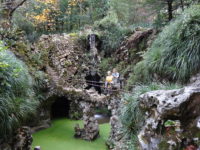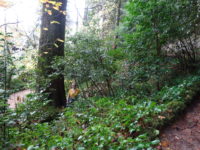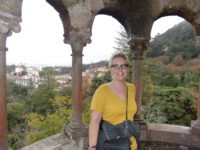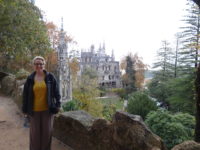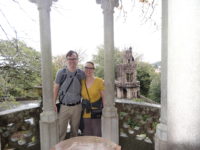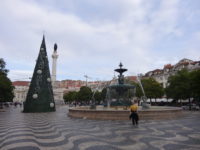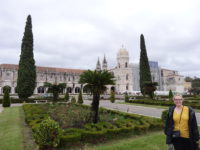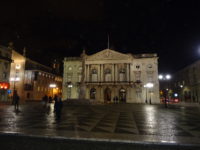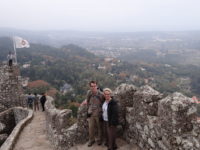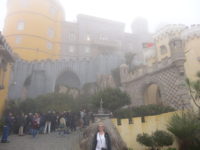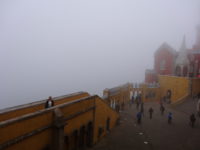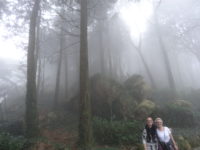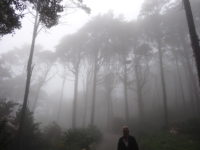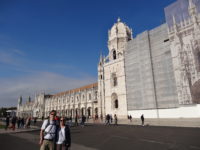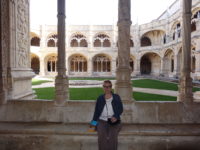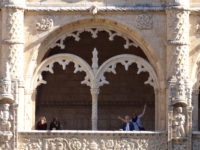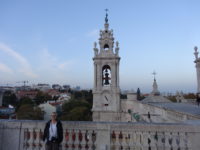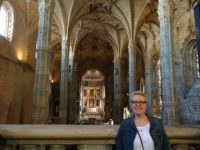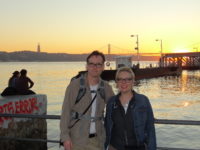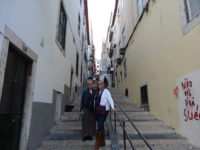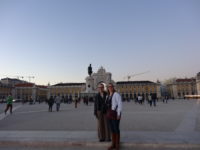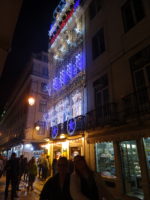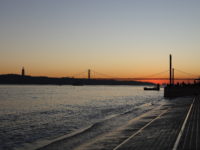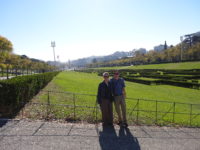 Sometimes, the touristic journey of 29,700 steps starts with one misstep. We started today heading out a little after 9:00, and after a little searching, we found a bakery down by the river so we could have rolls by the water. So far so good. It was a perfect day – all sun and comfortable temperatures, and it was a beautiful spot to eat breakfast. Meredith was sitting on the sea wall while Dubbs and I sat on a nearby bench. At least until Hitchcock showed up and twenty seagulls swooped in on Meredith to add to her group of pigeons. That made her retreat back to the bench, and that is when we realized she had sat in some seagull guano on the seawall. So, back to the apartment we went so she could change clothes. Then we set off to the bottom of the hill that our apartment was on, before Mer realized she had forgotten her guidebook. I volunteered to go back for it.
Sometimes, the touristic journey of 29,700 steps starts with one misstep. We started today heading out a little after 9:00, and after a little searching, we found a bakery down by the river so we could have rolls by the water. So far so good. It was a perfect day – all sun and comfortable temperatures, and it was a beautiful spot to eat breakfast. Meredith was sitting on the sea wall while Dubbs and I sat on a nearby bench. At least until Hitchcock showed up and twenty seagulls swooped in on Meredith to add to her group of pigeons. That made her retreat back to the bench, and that is when we realized she had sat in some seagull guano on the seawall. So, back to the apartment we went so she could change clothes. Then we set off to the bottom of the hill that our apartment was on, before Mer realized she had forgotten her guidebook. I volunteered to go back for it.
So it was we got underway about 10:00 or so. At the airport, we had bought “Lisboa Cards.” These cards get you discounts or free entries to various places around town, and they give you free access to buses, subways, and trams. We walked back to the train station, where we picked up a Metro train to take out to Edward VII Park. Oddly, rush hour in Lisbon seems to last until 10:30 promptly, when our train went from crowded to almost empty.
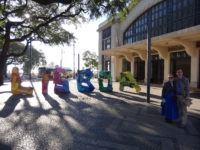
Edward VII Park was named for the English king who visited here in the early 1900s. It is a park located at the end of the boulevard we had seen last night, and we wanted to walk from the park down the boulevard. The park is excellent – there are still-flowering trees, well manicured lawns, monuments, a (currently turned off) fountain, and a huge building that may have been a palace at one point, but today was hosting a convention on power (of the electrical kind, not the kingly kind). The main park section was open and gave great views all the way down to the river.
We stopped by a huge monument to the man who helped rebuild Lisbon after most of it was destroyed after a 1755 earthquake. It also had a fountain that was turned off. I’m not sure if the fountains get turned off from thrift or fear of freezing, but it was a small shame that there was no water in the ones we saw.
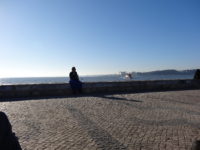 The boulevard was very pleasant, heavily lined with trees and shops. We took advantage of the latter by swinging in to a cafe to buy a hot chocolate for me so we would have a legitimate reason to use the bathroom. Rest stops like that are surprisingly important when touring, so you need to be strategic about them. Never pass up a free WC!
The boulevard was very pleasant, heavily lined with trees and shops. We took advantage of the latter by swinging in to a cafe to buy a hot chocolate for me so we would have a legitimate reason to use the bathroom. Rest stops like that are surprisingly important when touring, so you need to be strategic about them. Never pass up a free WC!
Mer started our official walking tour with a slight non-walking cheat – she took the funicular (uphill train) up to the Bairro Alto area above the main town. Dubbs and I walked up because we got tired of waiting for the tram and wanted to keep moving so things did not stiffen up from inaction. Portugal is built on and around seven hills, and so there are neighborhoods to explore that require changing elevation.
The Bairro Alto funicular stopped at a park at the top with great views of lower Lisbon and the bay. The very best viewpoint was under construction and so was fenced off, but it still had “a pleasant aspect,” as it were. We wandered the hill neighborhood until we came to a former monastery that had been converted to a beer hall. The inside walls were covered in tiles depicting scenes (the older ones dedicated to God, the newer ones dedicated to beer), and it seemed like an ideal place to have lunch.
 After the earthquake of 1755, the town was rebuilt, but the town left the ruins of a convent intact as a monument, and this was our next destination. They have also added a small archaeology museum that is eclectic, to say the least, with religious objects saved from monasteries, to a small library, to three mummies, to a display on excavations of a nearby mound. The real jewel was the convent, though. The ribs of the vaulted ceiling held up only sky, and it was hauntingly beautiful. Meredith pointed out accurately that she loved how the place inspired an awed hush – people were talking in low tones, if at all.
After the earthquake of 1755, the town was rebuilt, but the town left the ruins of a convent intact as a monument, and this was our next destination. They have also added a small archaeology museum that is eclectic, to say the least, with religious objects saved from monasteries, to a small library, to three mummies, to a display on excavations of a nearby mound. The real jewel was the convent, though. The ribs of the vaulted ceiling held up only sky, and it was hauntingly beautiful. Meredith pointed out accurately that she loved how the place inspired an awed hush – people were talking in low tones, if at all.
Since Lisbon is situated on some serious inclines, people have designed ways to deal with elevation. The funiculars are an obvious choice, and have been around since the late 1800s. They also have multiple elevators, including an iron one built around 1900. It is reminiscent of the Eiffel Tower, and in addition has an observation deck on top of the elevator shaft, which is accessed by a tightly winding spiral staircase. Since it was free to Lisboa Card holders, I went up, even though I knew I probably would not like the height. I was right, but I did stay for about two minutes before beating a hasty retreat back down to the safety of the enclosed elevator level.
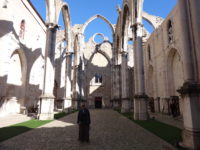 The top of the elevator is near a major shopping street, so we checked that out, which included a stop off at a gelato shop (Italian ice cream). The street itself had a few street performers and the cafes spilled out onto the street, so it was a festive place to walk down and back up.
The top of the elevator is near a major shopping street, so we checked that out, which included a stop off at a gelato shop (Italian ice cream). The street itself had a few street performers and the cafes spilled out onto the street, so it was a festive place to walk down and back up.
We finished our walking tour by heading over to the Miradouro de Santa Catarina square, which also had grand views of the downtown. There was also a statue of a large humanoid monster that represented the Cape of Good Hope, which was treacherous. A small bronze man, representing Portuguese explorers, was staring it down along with a resident pigeon.
We made our way back to a funicular that we took down a long, gentle slope. Until the street seemed to disappear – the hill had suddenly gotten roller-coaster steep. It stopped at the bottom, and we found ourselves one block from the apartment, where we took advantage of it for a half-hour rest and snooze-fest before heading out on scenic walk number two around 4:30.
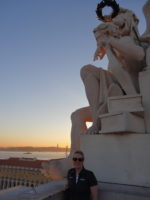 We headed back to the river and along it to Commerce Square. Since we had to pass under the huge arch on the land side of the square, and it was free on our Lisboa Cards, we decided to go up to the top of it. It was close to sunset, and the views were quite good, especially for being in the valley. There was a commanding view of the square, and the views of the shopping street behind the arch and surrounding areas were fine. We got to see the sculpture on top up close and appreciate how huge it is.
We headed back to the river and along it to Commerce Square. Since we had to pass under the huge arch on the land side of the square, and it was free on our Lisboa Cards, we decided to go up to the top of it. It was close to sunset, and the views were quite good, especially for being in the valley. There was a commanding view of the square, and the views of the shopping street behind the arch and surrounding areas were fine. We got to see the sculpture on top up close and appreciate how huge it is.
From the arch, we walked a short distance to an elevator, which took us up to a road, which after a short walk took us to another elevator, which emptied us out on a street which we could climb (up) to the castle. The castle and grounds were about to close, so we did not bother paying to go in, but we were able to wander inside the neighborhood inside the old walls, which is where the rich lived to be close to the king. Now it is filled with shops and restaurants and small homes of middle class people, which made it a good place to amble.
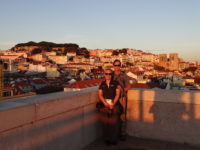
We left the ramparts behind, heading down through narrow streets. We lit upon a cute little square that had a restaurant with outdoor seating, so we had supper there. Mer asked for tap water to drink and the waiter shook his head no, but we laughed when at the end of the meal he brought Mer a small plastic bottle of spring water – it was very kind of him.
We were now at the top of the Alfama neighborhood, which is a cluster of houses and apartments that were not destroyed in the earthquake, and so the narrow, twisting streets still exist. We started from a pair of squares with excellent views of the valley, and then proceeded down stairs and streets, back down to the river. Mer then announced, at the unbelievably late hour of 8:00, that she had one more place to go see, so we found a Metro stop and took a couple of trains out to the Parque das Nacoes, a site where Lisbon hosed Expo 98 for 150-plus countries back in 1998.
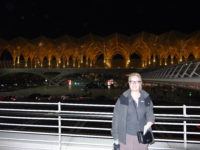 But that is not what we saw when we came out of the train station. We were confronted with a large three-story mall, designed with nautical themes and flanked by luxury apartments that were shaped like sails. I was a bit surprised by Mer taking us to a mall, since she is not a shopper, but then she explained the mall and train station (which was funky with arches and tree-like supports) were both designed by a famous architect, who also designed the newest bridge in Venice, Italy, which we had seen.
But that is not what we saw when we came out of the train station. We were confronted with a large three-story mall, designed with nautical themes and flanked by luxury apartments that were shaped like sails. I was a bit surprised by Mer taking us to a mall, since she is not a shopper, but then she explained the mall and train station (which was funky with arches and tree-like supports) were both designed by a famous architect, who also designed the newest bridge in Venice, Italy, which we had seen.
We walked through the mall, and enjoyed the elevator, which had a TV monitor that gave you your elevation, and when we went below sea level by a few meters, it “plunged” us under the ocean on the screen. Nice touch for an elevator.
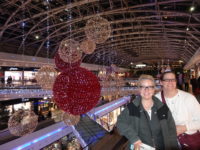
Behind the mall was the park, which is vast, and largely covered over by cobblestones and buildings from the Expo. We walked along the row of flags of the countries that had attended, then along the river, and ended near the new huge bridge across the Tagus. From there, we made our way back to the Metro, two trains to the central station, and by foot back home. The total walking for the day was about 29,700 steps, or 15.4 miles. It was also past 10:00. We were quite ready for bed.
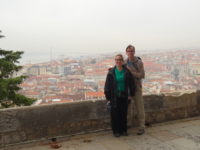 We kicked around several possibilities for today – going back to Sintra, exploring the beach town Cascais, or puttering around Lisbon. We settled on Lisbon, to finish up the couple of remaining sites we had not yet seen.
We kicked around several possibilities for today – going back to Sintra, exploring the beach town Cascais, or puttering around Lisbon. We settled on Lisbon, to finish up the couple of remaining sites we had not yet seen.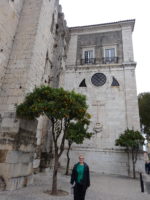
 We walked back down toward town, stopping in at a very cool art shop that seemed to be featuring creche (nativity) sets. Some were very moving in execution or simplicity; others were strangely whimsical. The shop itself was in an interesting space, with a rocky floor and a brick roof. Of course, my favorite works were over $1,200 and $800 each. I always seem to pick out the expensive ones.
We walked back down toward town, stopping in at a very cool art shop that seemed to be featuring creche (nativity) sets. Some were very moving in execution or simplicity; others were strangely whimsical. The shop itself was in an interesting space, with a rocky floor and a brick roof. Of course, my favorite works were over $1,200 and $800 each. I always seem to pick out the expensive ones.
